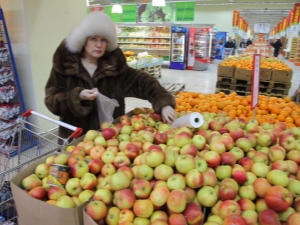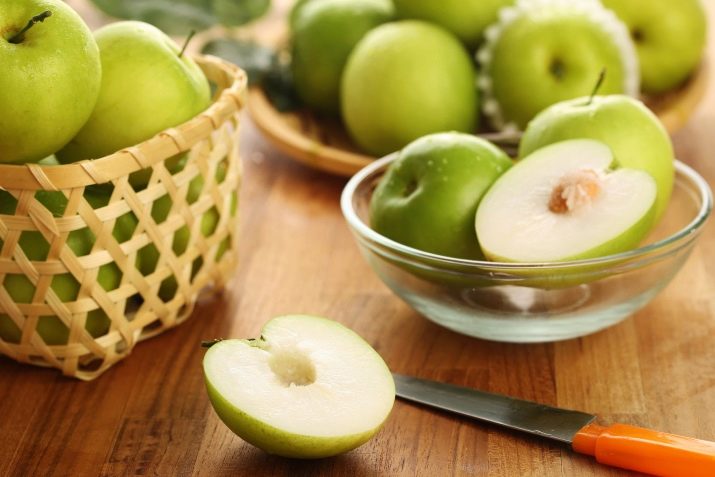Characteristics of apples according to GOST

Apples are the subject of trade, officially grown in the country fruit, which relates to food.That is why the quality, composition, appearance and taste characteristics of the product are subject to applicable standards - GOST.
Classification of varieties
Fresh apples are conventionally divided into several varieties.
Apples of extra class must have the highest quality, their visual parameters - the shape, as well as color and size, must fully correlate with the varietal characteristics. It is important that the cuttings remain intact and intact.
According to the current GOST standards, fresh apples are divided into 4 categories depending on the color of the fruit.
Group A is apples of red varieties, in this case separate parameters are characteristic for different classes:
- extra - at least 3/4 of the surface is covered with reddish skin;
- class 1 - not less than half;
- class 2 - not less than a quarter.
Category B is a mixed color variety, with:
- extra - contains at least 1/3 of red color;
- class 1 - at least one third;
- class 2 - red painted at least one tenth of the surface.
Category C - combines striped varieties of apples with mild color.
- extra - red skin is not less than 1/3 of the entire surface;
- class 1 and class 2 - at least 1/10 of the entire surface of apples is colored in shades of red.
D - this category includes all other varieties.
Requirements for fruits and their characteristics
Only peeled and dirt, fresh-looking fruit, which have color, size and shape, characteristic of a particular type, are allowed to be sold at retail outlets. The first-grade apples are most often supplied to the stores or they are also called the first category.
Such products are whole, they are not beaten, not bitten by rodents, not pecked by birds. The flesh of such apples must necessarily be white and juicy with no obvious signs of wilting. Putrid processes in the near-space space, as well as directly in the seed chamber itself, are unacceptable.
Apple fruits should be carefully removed from the fruit tree - the dents and softness that appears in fruits when falling on the ground is a defective sign of the fruit.
The condition of the lot must be such that they can endure long-term storage and transportation.
Possible defects and control methods
Among the unacceptable defects according to GOST, there are damages to apples that immediately relate to marriage:
- the presence of chemicals;
- the presence of stuck pieces of soil;
- worminess;
- the beginning of putrefactive processes;
- dry bark defects, the total area of which reaches 30 percent or more of the entire surface of the fruit;
- signs of frostbite;
- steamed fruit;
- the presence of depressed grayish spots near the calyx - bitter pit;
- damage caused by rodents and birds;
- internal necrosis;
- browning or blackening of softness - this often occurs in the case of treatment with carbon dioxide;
- seed chamber rot;
- the presence of spots under the thin skinned.
The more serious shortcomings according to GOST include:
- darkening pushes, if their diameter is more than 1 cm;
- pronounced grid, which occupies over 30% of the total surface of the apple;
- mechanical damage to the inside - the pulp;
- the ugliness of fruit fruits;
- clear signs of aging over 30%;
- necrotic brown spots resulting from thermal burns;
- vitreousness;
- corky spots near brown or brown lenticulars;
- yellow skin on green varieties of apples;
- redness of the pulp of the near-chamber cell;
- softness and softening of the pulp.
Among the minor signs that do not affect the commercial use, the following are distinguished:
- external violations of the skin size not exceeding 2 cm and a total area not exceeding 1 square. cm;
- non-contrast presses of less than 1 sq. m. cm;
- no more than two uboin, whose parameters do not exceed 5 mm.
Apples are allowed for sale with minor integrity defects in case their number is minimal in the whole batch. For imported fruits, one form defect is allowed, as well as coloring and peel for the whole delivery, up to three for the Russian product.
The quality control of apples is carried out by random sampling: at the same time, from a batch to 100 units, the sample is 3 apples, if the number of fruits in a batch is more than a hundred, then 1 apple is added for every 50 subsequent units. Apples are evaluated for appearance, as well as taste, color and smell by organoleptic methods.
Packaging and labeling
According to GOST10131, 17812 and 20463, fresh apples must be packed in wooden pallets or in special containers. At the same time, fruits of the highest category are packed exclusively in wooden boxes.
The container must be free from debris and dirt, completely dry and free from any foreign smell.
In each package must be placed fruit of one variety.
Fruits of the highest and first categories are placed in boxes in several rows, while boxes are laid out with paper, and chips are poured over the fruit. In some cases, instead of chips, corrugated cardboard is laid so that with its smooth side it faces the apples.
Apples of the second category are placed in containers in bulk with the mandatory laying of sawdust or wood shavings on the bottom.
Each unit of packaging is glued with etiquette with obligatory marking: for the highest category - blue, for 1 category - red, for the second - green.
The label must indicate the name of the transported goods, the name of the sending company, the name of the variety, as well as the size of the apples and the date of packaging.
Transportation and storage
Apples are subject to transportation by all varieties of closed vehicles. In some cases, the movement of apples in open transport with the indispensable protection from the adverse effects of precipitation and low temperatures is allowed.
Fruit storage is performed in a dry, dark place, protected from sunlight. For greater keeping quality, fruits are wrapped in oiled paper or put in sawdust.
Shortly before moving to the point of sale, apples are removed from storage, but it is not recommended to transfer them to a room with warm air right away, first stand at a temperature of about +10 degrees, and only then under normal conditions.
You will learn more about apples from the following video.



























